Here is a correction that solves whether the input image is rotated cw or ccw in Python/OpenCV.
- Read the input
- Read the template (for its dimensions)
- Convert the input to gray and threshold
- Pad the threshold (to preserve the corners when applying morphology)
- Apply morphology close
- Remove the padding
- Get the largest external contour
- Get its perimeter and approximate to 4 corners as the input corners for the warping
- Sort the corners by Y and test the first two sorted corners for X. If diff=X2-X1 is negative, then the output corners need to be list in a slightly differently order.
- Get the output corners for the warping from the dimensions of the template and the diff of the sorted corners.
- Get the perspective transformation matrix
- Warp the input to match the template
- Save the results
Input 1 (cw rotated):
 :
:
Input 2 (ccw rotated):

import cv2
import numpy as np
# read image
#img = cv2.imread("omr_test.jpg")
img = cv2.imread("omr_test2.jpg")
hh, ww = img.shape[:2]
# read template
template = cv2.imread("omr_template.jpg")
ht, wd = template.shape[:2]
# convert img to grayscale
gray = cv2.cvtColor(img, cv2.COLOR_BGR2GRAY)
# do otsu threshold on gray image
thresh = cv2.threshold(gray, 0, 255, cv2.THRESH_BINARY+cv2.THRESH_OTSU)[1]
# pad thresh with black to preserve corners when apply morphology
pad = cv2.copyMakeBorder(thresh, 20, 20, 20, 20, borderType=cv2.BORDER_CONSTANT, value=0)
# apply morphology
kernel = cv2.getStructuringElement(cv2.MORPH_ELLIPSE, (15,15))
morph = cv2.morphologyEx(pad, cv2.MORPH_CLOSE, kernel)
# remove padding
morph = morph[20:hh+20, 20:ww+20]
# get largest external contour
contours = cv2.findContours(morph, cv2.RETR_EXTERNAL, cv2.CHAIN_APPROX_SIMPLE)
contours = contours[0] if len(contours) == 2 else contours[1]
big_contour = max(contours, key=cv2.contourArea)
# get perimeter and approximate a polygon
peri = cv2.arcLength(big_contour, True)
corners = cv2.approxPolyDP(big_contour, 0.04 * peri, True)
# draw polygon on input image from detected corners
polygon = img.copy()
cv2.polylines(polygon, [corners], True, (0,255,0), 2, cv2.LINE_AA)
# print the number of found corners and the corner coordinates
# They seem to be listed counter-clockwise from the top most corner
print(len(corners))
print(corners)
# reformat input corners to x,y list
sortcorners = []
for corner in corners:
pt = [ corner[0][0],corner[0][1] ]
sortcorners.append(pt)
icorners = np.float32(sortcorners)
# sort corners on y
def takeSecond(elem):
return elem[1]
sortcorners.sort(key=takeSecond)
# check if second corner x is left or right of first corner x
x1 = sortcorners[0][0]
x2 = sortcorners[1][0]
diff = x2 - x1
print(x1, x2)
# get corresponding output corners from width and height
if diff >= 0:
ocorners = [ [0,0], [0,ht], [wd,ht], [wd,0] ]
else:
ocorners = [ [wd,0], [0,0], [0,ht], [wd,ht]]
ocorners = np.float32(ocorners)
# get perspective tranformation matrix
M = cv2.getPerspectiveTransform(icorners, ocorners)
# do perspective
warped = cv2.warpPerspective(img, M, (wd, ht))
# write results
cv2.imwrite("omr_test2_thresh.jpg", thresh)
cv2.imwrite("omr_test2_morph.jpg", morph)
cv2.imwrite("omr_test2_polygon.jpg", polygon)
cv2.imwrite("omr_test2_warped.jpg", warped)
# display it
cv2.imshow("thresh", thresh)
cv2.imshow("pad", pad)
cv2.imshow("morph", morph)
cv2.imshow("polygon", polygon)
cv2.imshow("warped", warped)
cv2.waitKey(0)
Result for first input (cw rotated):

Result for second input (ccw rotated):











